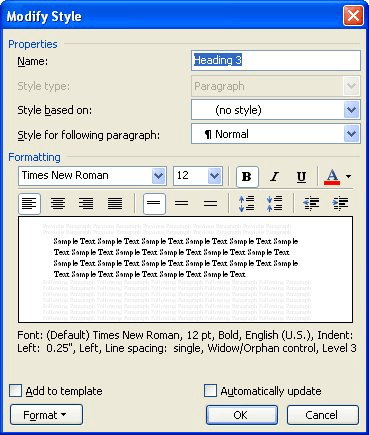Please Note: This article is written for users of the following Microsoft Word versions: 97, 2000, 2002, and 2003. If you are using a later version (Word 2007 or later), this tip may not work for you. For a version of this tip written specifically for later versions of Word, click here: Changing Styles.
Written by Allen Wyatt (last updated October 31, 2020)
This tip applies to Word 97, 2000, 2002, and 2003
Once you have defined a style in Word, you can change it at any time. To do this, follow these steps if you are using Word 2002 or Word 2003:

Figure 1. The Modify Style dialog box.
If you are using Word 97 or Word 2000, the process is a bit different. Follow these steps to change a style:
WordTips is your source for cost-effective Microsoft Word training. (Microsoft Word is the most popular word processing software in the world.) This tip (371) applies to Microsoft Word 97, 2000, 2002, and 2003. You can find a version of this tip for the ribbon interface of Word (Word 2007 and later) here: Changing Styles.

Discover the Power of Microsoft Office This beginner-friendly guide reveals the expert tips and strategies you need to skyrocket your productivity and use Office 365 like a pro. Mastering software like Word, Excel, and PowerPoint is essential to be more efficient and advance your career. Simple lessons guide you through every step, providing the knowledge you need to get started. Check out Microsoft Office 365 For Beginners today!
If you have problems with Word freezing at times, it can be very frustrating. Here are a couple of things you can check ...
Discover MoreNeed to get rid of direct, explicit formatting applied to a document? Here's an easy way to do it using familiar Word tools.
Discover MoreStyles are invaluable when it comes to applying consistent formatting in and across documents. If you need to rename a ...
Discover MoreFREE SERVICE: Get tips like this every week in WordTips, a free productivity newsletter. Enter your address and click "Subscribe."
There are currently no comments for this tip. (Be the first to leave your comment—just use the simple form above!)
Got a version of Word that uses the menu interface (Word 97, Word 2000, Word 2002, or Word 2003)? This site is for you! If you use a later version of Word, visit our WordTips site focusing on the ribbon interface.
Visit the WordTips channel on YouTube
FREE SERVICE: Get tips like this every week in WordTips, a free productivity newsletter. Enter your address and click "Subscribe."
Copyright © 2026 Sharon Parq Associates, Inc.
Comments